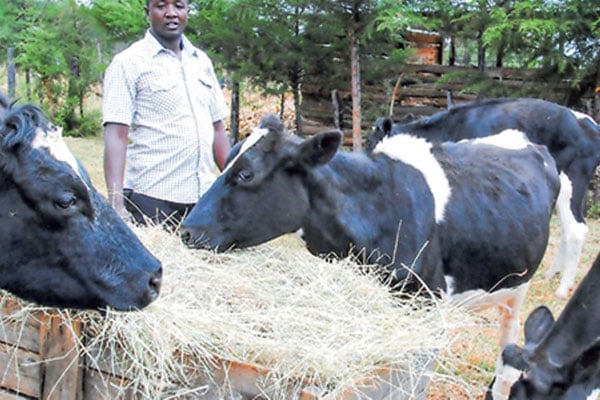Prime
Technology ensures effective cow pregnancy

Marnix Weeda displays the Alertys OnFarm test kit which can help on pregnancy diagnostics. Photo | George Katongole.
What you need to know:
- Achieving up to 40 litres of milk per day from a dairy cow is possible but this goes hand-in hand with a good insemination programme and overall herd management.
Farmers ought to know the cows that are working for them instead of keeping needless stock.
The quicker a cow gets pregnant by shortening the calving period, the more milk the farmer gets and the more farmers can improve their economic performance.
Globally, records state that every day the cow does not have a calf in it, it is costing the farmer money. In Uganda, it is estimated to cost a farmer between Shs10,000 and Shs15,000 a day amounting to about Shs3m a year.
“Simply put, if the pregnancy diagnosis is not at a good level, your costs go up,” Marnix Weeda, the regional sales manager of Alertys, a pregnancy test kit says.
The Alertys OnFarm test kit is available in Uganda to help dairy farmers reach 80 percent pregnancy rate every year. The test kit was launched in Uganda last month with a focus to reach 100,000 smallholder farmers at first and 1,000 inseminators.
To achieve the 80 percent success rate, forward-thinking farmers ought to use artificial insemination of carefully selected semen to avoid using bulls which are prone to challenges of in-breeding.
However, in Uganda, the pregnancy rate stands at around 30 percent among most of the farmers. This implies that in a herd of 100 cows in Uganda, up to 70 miss getting pregnant at the right time piling up costs for the farmer.
To better understand the costs, a quality heifer that costs up to Shs4m, adding to feeding costs of up to Shs3m a year per cow and labour costs up to Shs250,000 a month.
Improving performance
By using the Alertys OnFarm test kit, farmers and veterinarians can diagnose pregnancy without the need to palpate or use ultrasound.
The veterinarians will spend less time checking cows and focus more on problem cows and open cows as well as providing advice on herd management during their visits.
The pregnancy test detects the pregnancy associated proteins that only appear when the embryo attaches to the uterus which means that only when the cow is pregnant are these proteins released. The proteins can be detected after about 28 days after insemination.
Weeda says that there is a common occurrence of embryo death especially in the first 60 to 90 days. Up to 20 percent of dairy cows are estimated to lose the embryo due to diseases and stress-related issues such as lack of proper nutrition and water.
Dr Hamid Lutalo, the regional director of Genex Urus, emphasises proper diagnostics for dairy farmers to help farmers get value for money.
Advantages of the test
The test can be done on cows before they are taken into a community breeding programme, to identify open cows, detect embryonic losses and to avoid drying off an open cow.
Just like the common tests, a blood sample is taken from under the tail and drawn on the pipette by adding six drops. A separate needle is needed to collect samples from each animal to be tested. Each tube should be labelled with an animal ID to prevent confusion. A separate pipette should be used for each device.
Farmers are able to control the process as much as possible. It is an easy test that can be performed on the cow with an accuracy rate of up to 99.7 percent while it gives the farmer the opportunity to rebreed in a timely manner.
The test takes about 20 minutes with results appearing as early as five minutes. The animal is pregnant when the test line is red or pink. The animal is non-pregnant if no test line appears.
One of the biggest annoyances to farmers is that they have to wait for technicians to detect the pregnancy.
The waiting period is normally after two months following an insemination, but with the test, pregnancy can be detected after 28 days.
Pregnancy diagnosis is about Shs10,000 per cow upwards by the technicians coupled with a 20 percent loss in the first trimester.
Dr Patrick Sekimpi, the chairman Dairy Farmers Network, a farmer in Busiika, Luweero with 80 milking cows explains that the benefits are outstanding. The test kit costs Shs35,000. The test can help farmers correct with the synchronisation programme.




